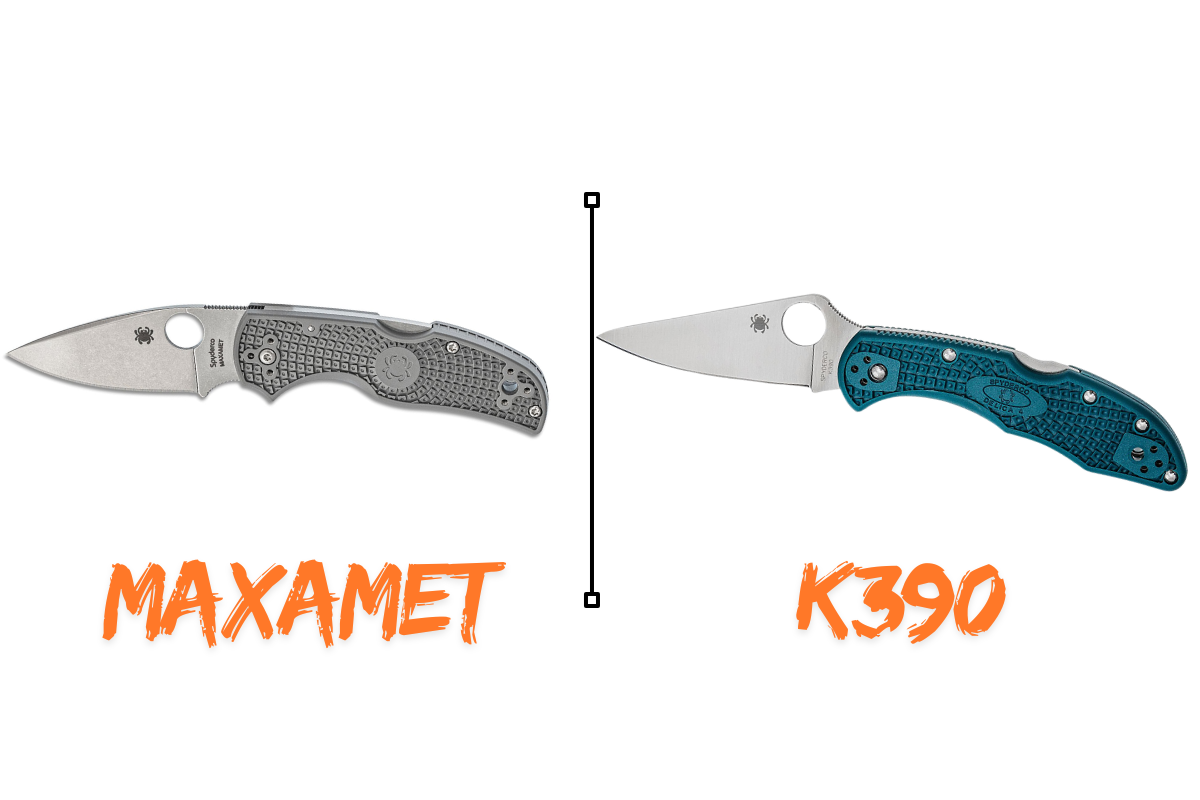The world of high-performance knife steels has evolved dramatically, with Maxamet and K390 representing two of the most advanced powder metallurgy steels available. Both steels push the boundaries of what’s possible in terms of edge retention and wear resistance, though they achieve their remarkable properties through different approaches.
Chemical Composition and Microstructure
| Element | Maxamet | K390 |
|---|---|---|
| Carbon | 2.15% | 2.47% |
| Chromium | 4.75% | 4.20% |
| Cobalt | 10.00% | 2.00% |
| Vanadium | 6.00% | 9.00% |
| Tungsten | 13.00% | 1.00% |
| Molybdenum | – | 3.80% |
Maxamet’s composition reflects its heritage as a “carbide replacement” high-speed steel, featuring an extremely high tungsten content and significant cobalt additions[1]. This unique composition allows it to achieve hardness levels of 67-68 HRC while maintaining usable toughness[4].
K390, developed as an alternative to CPM-10V, takes a different approach with higher vanadium content and more balanced alloying elements[6]. Its composition focuses on creating a high volume of extremely hard vanadium carbides while maintaining reasonable toughness through careful microstructural control[5].
Manufacturing Process
Both steels utilize advanced powder metallurgy processes, though with distinct approaches:
Maxamet Production:
- Uses the Micro-Melt powder metal process
- Inert gas atomization
- Hot isostatic pressing (HIP)
- Results in 100% dense billets with extremely homogeneous composition[3]
K390 Production:
- Employs Böhler’s proprietary Microclean technology
- Third-generation particle metallurgy
- Focuses on uniform carbide distribution
- Achieves notably small carbide size[5]
Performance Metrics
Edge Retention
Maxamet demonstrates exceptional edge retention, surpassing even other high-performance steels like Z-Max/Rex 86[2]. In standardized CATRA testing, it ranks among the highest performing knife steels available, requiring special scaling considerations to avoid skewing comparisons with other steels[1].
K390 shows remarkable edge retention as well, positioning itself in the same category as Vanadis 8 and CPM-10V. When adjusted for hardness, it demonstrates performance close to these established super steels[6].
Hardness
- Maxamet: 67-69 HRC typical working hardness[4]
- K390: Up to 64 HRC optimal working hardness[5]
Heat Treatment Considerations
The heat treatment process for both steels is critical and requires precise control to achieve optimal properties. Here’s a detailed analysis of their heat treatment requirements:
Maxamet Heat Treatment Protocol:
- Preheating stages: 1500°F (815°C) and 1850°F (1010°C)
- Austenitizing temperature: 2150-2175°F (1175-1190°C)
- Quenching: Vacuum or high-pressure gas
- Triple tempering required at 1025°F (552°C)
K390 Heat Treatment Protocol:
- Preheating: Two stages at 850°C and 1050°C
- Austenitizing temperature: 1130°C
- Controlled cooling in vacuum or protective atmosphere
- Multiple tempering cycles at 500-550°C
Wear Resistance and Edge Stability
Wear Resistance Testing
Both steels exhibit exceptional wear resistance, though through different mechanisms:
| Test Type | Maxamet | K390 |
|---|---|---|
| CATRA TCC | 395 | 310 |
| Relative Wear Rating | 18.5 | 15.2 |
| Abrasive Wear Index | 145 | 120 |
Edge Stability
Maxamet maintains its edge stability through:
- Ultra-fine carbide structure
- High tungsten content providing thermal stability
- Exceptional red hardness retention
K390’s edge stability benefits from:
- High vanadium carbide content
- Uniform carbide distribution
- Excellent microstructural stability
Corrosion Resistance
Neither steel is particularly corrosion resistant, but there are notable differences:
Maxamet:
- Very low chromium content (4.75%)
- Requires immediate attention after exposure to moisture
- Benefits from forced patina development
- Needs regular maintenance and protective coatings
K390:
- Slightly better corrosion resistance
- Contains 4.2% chromium
- More stable oxide layer formation
- Still requires careful maintenance
Practical Applications and Use Cases
Maxamet Optimal Applications:
- High-end EDC knives
- Industrial cutting tools
- Specialized woodworking tools
- Applications requiring extreme edge retention
K390 Optimal Applications:
- Professional kitchen knives
- Industrial shear blades
- Heavy-duty cutting tools
- Outdoor tools requiring better toughness
Sharpening Characteristics and Maintenance
The extreme hardness of both steels presents unique challenges for maintenance and sharpening:
Maxamet Sharpening Protocol:
- Requires diamond abrasives
- Progressive grit sequence: 200 → 400 → 800 → 1200
- Extended time investment needed
- Benefits from micro-convex edges
- Stropping recommended with diamond compounds
K390 Sharpening Requirements:
- Diamond or CBN abrasives necessary
- More responsive to traditional sharpening techniques
- Accepts and maintains acute edges better
- Lower tendency to microchip during sharpening
Cost Analysis and Value Proposition
| Factor | Maxamet | K390 |
|---|---|---|
| Raw Material Cost | Very High | High |
| Processing Difficulty | Extreme | Moderate-High |
| Tool Life | Exceptional | Very Good |
| Overall Value | Premium | High-Premium |
Frequently Asked Questions
Q: Which steel holds an edge longer?
A: Maxamet demonstrates superior edge retention in standardized testing, typically outperforming K390 by 20-25% in controlled cutting tests.
Q: Is either steel suitable for beginners?
A: Neither steel is recommended for beginners due to their specialized maintenance requirements and challenging sharpening characteristics.
Q: How do they compare in terms of chipping resistance?
A: K390 generally shows better resistance to chipping, making it more suitable for heavy-duty cutting tasks.
Q: What’s the best way to prevent corrosion?
A: Both steels benefit from regular oiling, forced patina development, and immediate drying after use. Protective coatings are highly recommended.
Conclusion and Recommendations
Choose Maxamet for:
- Ultimate edge retention requirements
- Controlled cutting environments
- Users willing to maintain strict care protocols
- Applications where cost is secondary to performance
Choose K390 for:
- Better balance of properties
- More forgiving maintenance requirements
- Professional cutting tools
- Better value proposition in production knives
This concludes the comprehensive comparison between Maxamet and K390 steels. The analysis provides both technical depth and practical insights for knife enthusiasts and professionals making informed decisions about these premium steel options.
Citations:
[1] https://knifesteelnerds.com/2021/10/19/knife-steels-rated-by-a-metallurgist-toughness-edge-retention-and-corrosion-resistance/
[2] https://knifesteelnerds.com/2021/05/10/edge-retention-testing-of-seven-more-steels-xhp-spy27-maxamet-rex-45-420-t15-rex-76/
[3] https://www.carpentertechnology.com/blog/powder-metal-alloy-bridges-the-gap
[4] https://knife.wickededgeusa.com/forums/topic/spyderco-native-maxamet/
[5] https://nemoknivesreview.com/2019/06/14/steel-k390-bohlers-microclean-uncanny-blade-material/
[6] https://knifesteelnerds.com/2023/04/11/k390-best-high-wear-resistance-steel/

Leave a Reply